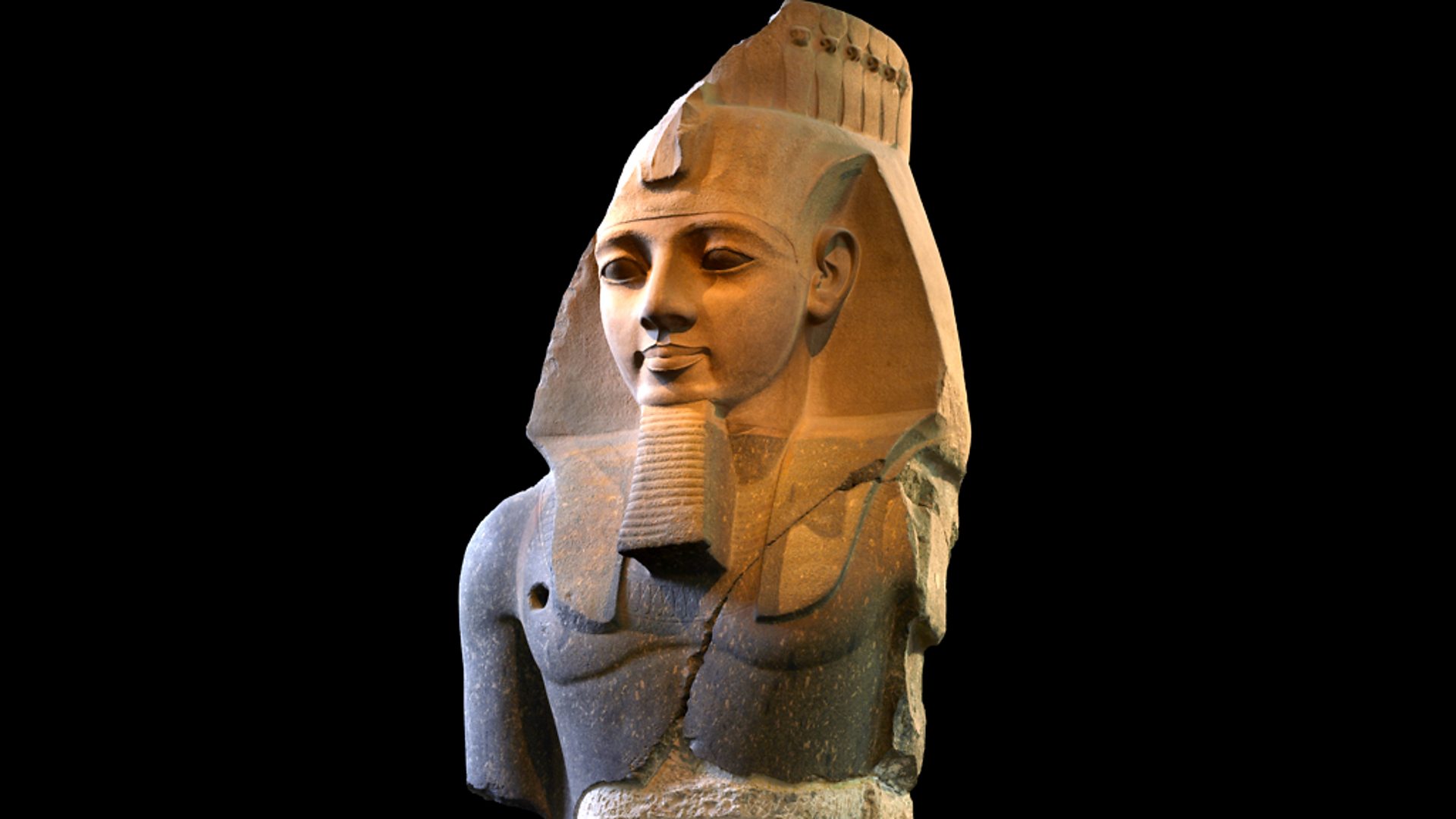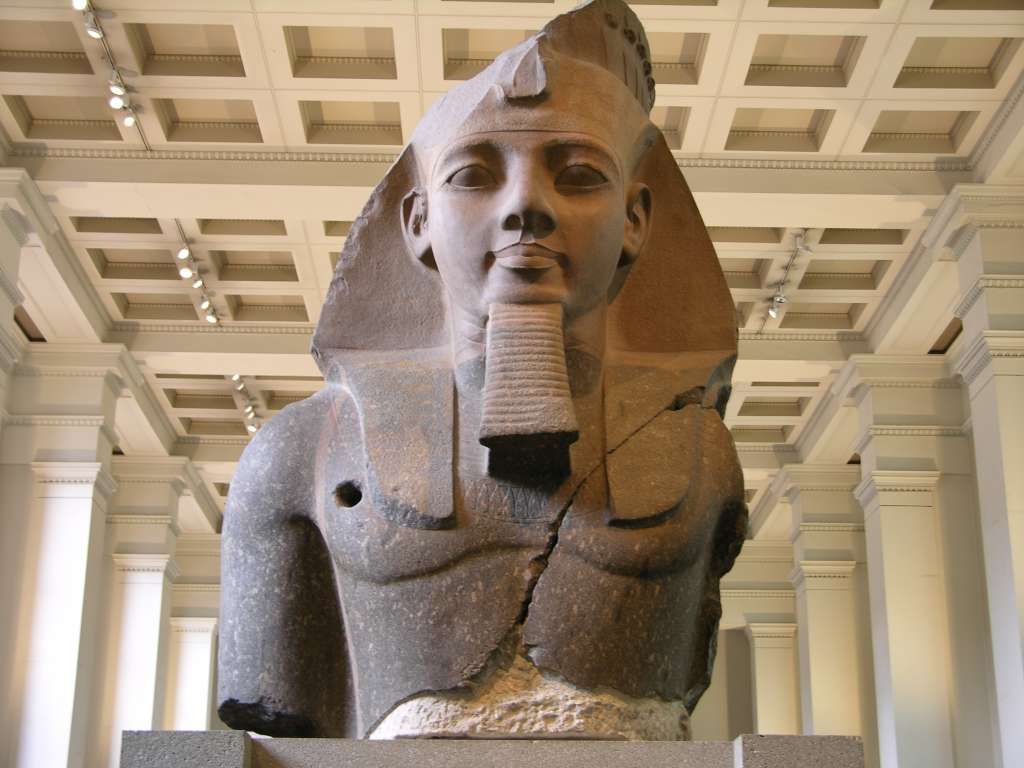Introduction
Towering majestically before the entrance to the Ramesseum, the colossal statue of Ramses II stands as a testament to the enduring legacy of one of ancient Egypt’s most renowned pharaohs. This monumental work of art, carved from the striking combination of pink and grey granite, offers a captivating glimpse into the artistic and cultural achievements of the Ramesside era.

In this blog post, we will delve into the intricate details of this remarkable statue, examining its design, symbolism, and the historical context that surrounds it. From the intricate hieroglyphic inscriptions to the exploited bichrome nature of the stone, we will uncover the fascinating story behind this impressive artistic creation.
The Ramesseum and the Colossal Statue of Ramses II
The Ramesseum, located in the ancient city of Thebes (modern-day Luxor), was the mortuary temple of Ramses II, one of the most powerful and influential pharaohs of ancient Egypt. Constructed during the 19th dynasty, the Ramesseum was a grand and imposing structure, designed to commemorate the achievements and legacy of the great king.
At the entrance to this impressive temple, a pair of colossal statues of Ramses II once stood, guarding the doorway and commanding the attention of all who approached. The statue we will be exploring is one of these impressive figures, a testament to the skill and artistry of the ancient Egyptian sculptors.
The Statue’s Composition and Craftsmanship
The monumental statue of Ramses II is carved from a striking combination of pink and grey granite, a material that was highly prized in ancient Egypt for its durability and beauty. The sculptor has skillfully exploited the bichrome nature of the stone, using the contrast between the two colors to emphasize the division between the body and the face of the pharaoh.

The statue depicts Ramses II wearing the traditional nemes headdress, a distinctive head-cloth that was a symbol of royal authority in ancient Egypt. Atop the nemes, the pharaoh wears a circlet of uraei, or rearing cobras, which represented the divine protection of the goddess Wadjet.
One of the most striking features of the statue is the dorsal pillar, which is inscribed with vertical registers of hieroglyphic text. These inscriptions provide valuable information about the identity and titles of the king, as well as a dedication to the god Amun-Ra, one of the most important deities in the ancient Egyptian pantheon.
Symbolism and Significance
The colossal statue of Ramses II at the Ramesseum was not merely a work of art, but a powerful symbol of the pharaoh’s divine right to rule. The use of the nemes headdress and the circlet of uraei were deliberate choices, imbuing the statue with a sense of regal authority and divine connection.
The bichrome nature of the stone, with its striking contrast between the pink and grey hues, also held symbolic significance. In ancient Egyptian art and culture, color was often used to convey deeper meanings and associations. The division between the body and the face of the pharaoh may have been intended to represent the duality of his nature – the physical and the divine, the mortal and the immortal.
The hieroglyphic inscriptions on the dorsal pillar further emphasized the importance of the statue, providing a clear and unambiguous declaration of the pharaoh’s identity and his connection to the gods. By invoking the name and titles of Ramses II, as well as a dedication to Amun-Ra, the statue served as a tangible representation of the pharaoh’s power and his divine right to rule.
Historical Context and Significance
The colossal statue of Ramses II at the Ramesseum was not an isolated work of art, but rather a part of a larger cultural and historical context. Ramses II, also known as Ramesses the Great, was one of the most powerful and influential pharaohs of the 19th dynasty, reigning for over 60 years and leaving an indelible mark on the history of ancient Egypt.

During his reign, Ramses II embarked on a extensive building program, constructing numerous temples, monuments, and statues throughout the kingdom. The Ramesseum, with its pair of colossal statues guarding the entrance, was one of the most impressive and significant of these projects, a testament to the pharaoh’s desire to project an image of power, wealth, and divine authority.
The fact that the statue was noted to have traces of color in 1817 suggests that it may have been painted red in antiquity, further enhancing its visual impact and symbolic significance. The use of color in ancient Egyptian art was not merely decorative, but rather a means of conveying deeper meanings and associations. The red pigment, for example, may have been used to symbolize the sun, the power of the pharaoh, or the blood of the gods.
The Statue’s Condition and Preservation
Over the centuries, the colossal statue of Ramses II at the Ramesseum has endured the ravages of time, natural disasters, and human intervention. The statue is now missing approximately half of its original form, with the lower body and legs no longer intact. This loss of the statue’s physical integrity, however, does not diminish its significance or the importance of preserving and studying this remarkable work of art.
The efforts of archaeologists, historians, and cultural heritage specialists have been instrumental in ensuring the ongoing preservation and study of the Ramesseum and its associated artifacts, including the colossal statue of Ramses II. Through careful documentation, conservation, and restoration efforts, the statue’s remaining features have been protected and made accessible to scholars and the public alike.
Conclusion: Appreciating the Enduring Legacy of Ramses II
The colossal statue of Ramses II at the Ramesseum stands as a testament to the artistic and cultural achievements of ancient Egypt. This remarkable work of art, with its striking bichrome composition, intricate hieroglyphic inscriptions, and symbolic associations, offers a window into the world of one of the most powerful and influential pharaohs in history.
As we continue to study and appreciate this monumental statue, we are reminded of the enduring legacy of Ramses II and the enduring power of ancient Egyptian art and culture. Through the careful preservation and study of this and other artifacts, we can gain a deeper understanding of the past and the remarkable achievements of the ancient Egyptians, inspiring us to continue exploring and celebrating the wonders of this remarkable civilization.

